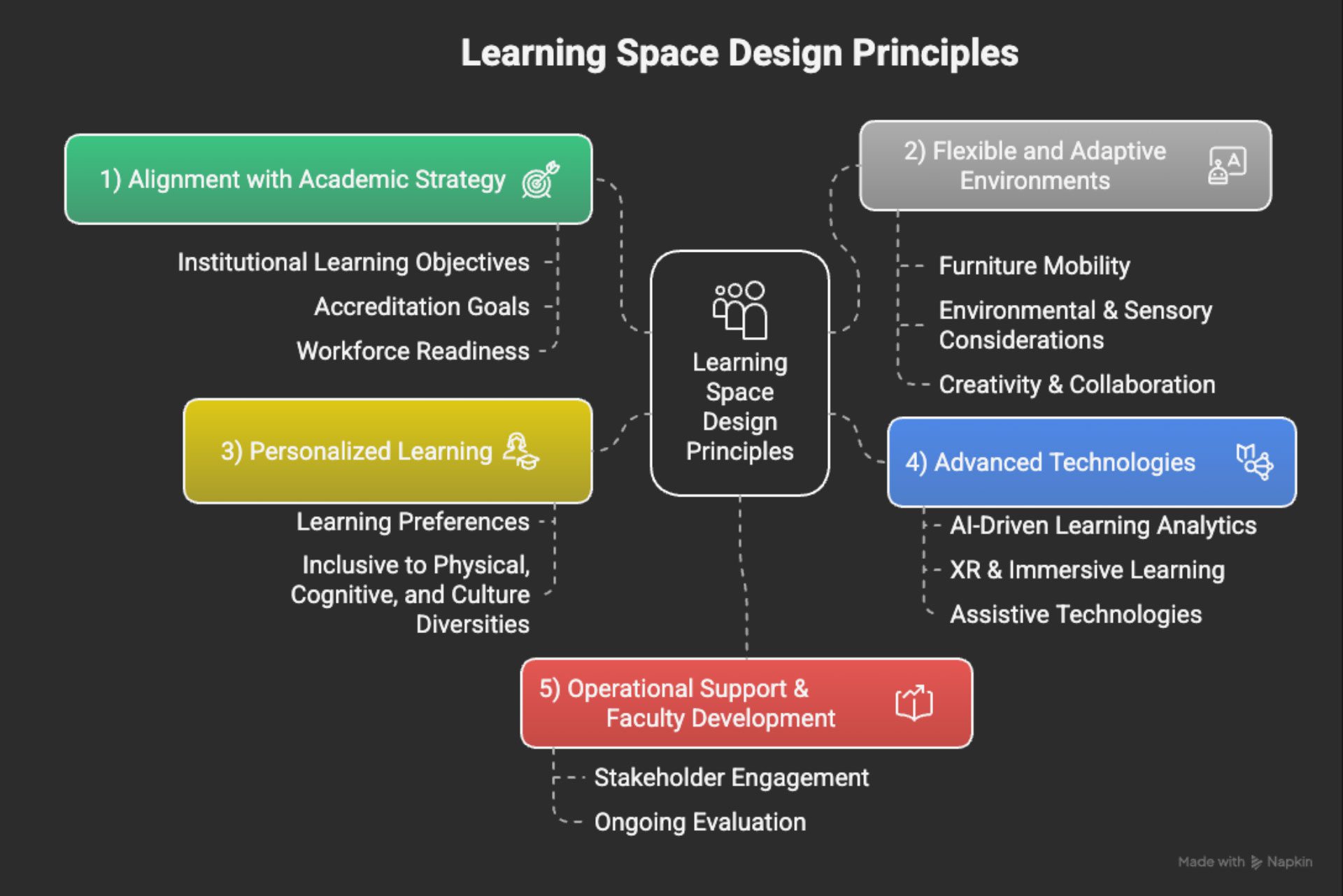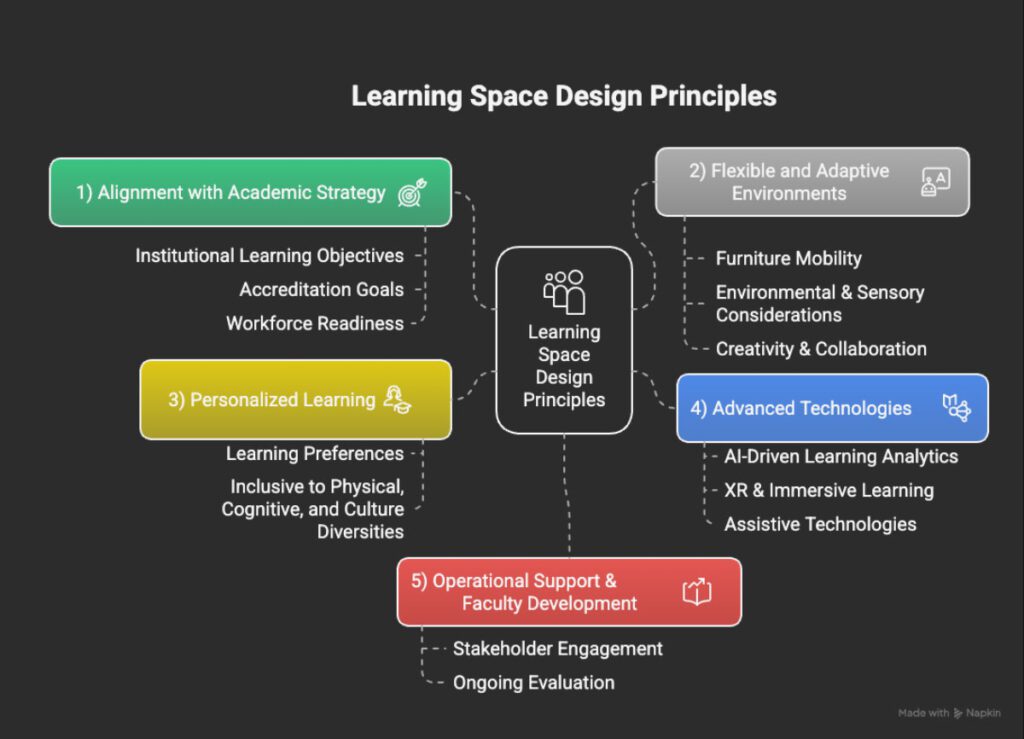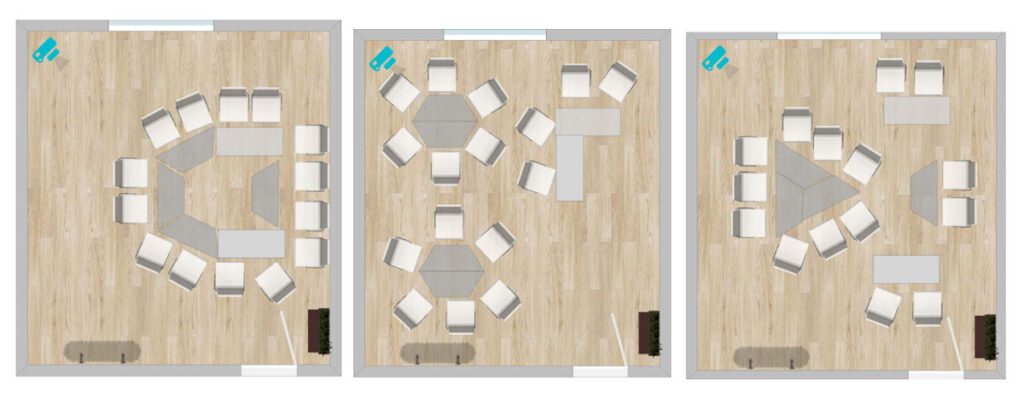Learning Space Design Principles:
Aligning Educational Environments with Effective Strategy

Over the past decade, the educational sector has invested billions of dollars and human resources into the relentless pursuit of technological “enhancements” for learning. As new disruptive technologies constantly shift the landscape every year, this community’s attention is dominated by the exploration and potential implementation/evaluation of these technological tools.
While assessing technology’s impact on education is vital, educators must also consider the daily learning environment and platforms shaping the student and teacher experience. Today’s “classroom” deserves fresh attention as shifts in technology, pedagogy, and workforce needs redefine 21st-century learning. This shift is already in motion, propelled by initiatives that reflect priorities and outcomes distinct from those of previous eras. 2,3,4,5
This conversation is framed through the lens of the ‘learner-centered’ paradigm and navigates sets of data from Project Praxeum (℅ Air University Innovation Accelerator [AUiX]), resources from EDUCAUSE 6, and other research outcomes 7,8, to inform the establishment of “Learning Space Design Principles” (LSDP). The terminology of “Learning Space” is intentionally chosen to break the mold of the traditional “classroom” imagery, thereby opening the walls both literally and figuratively for new opportunities. As principles of design, these foundational components can be more specifically scoped and fit together based on any respective contexts.
Figure 1: Learning Space Design Principles (LSDP)

1 https://www.reachcapital.com/2024/02/09/at-2-8b-2023-u-s-edtech-funding-is-back-to-pre-pandemic-days-but-in-a-very-different-world/
2 The Student-Centered Activities for Large Enrollment Undergraduate Programs (SCALE-UP) Project, North Carolina State University
3 Engaged and Active Student Learning (EASL), Auburn University
4 Technology Enabled Active Learning (TEAL), MIT
5 SPACES, EdFarm
6 Learning Space Rating System (LSRS), EDUCAUSE
7 Project Zero, Harvard University
8 Future Classroom Lab, Harran University
LSDP 1. Alignment with Academic Strategy
Like any organization or initiative, a work must align with its mission and/or the problem it’s solving. Learning spaces are no exception.
Physical environments should not be designed in isolation from the educational goals they are intended to support. Instead, space design must be intentionally aligned with institutional learning objectives, accreditation requirements, and workforce readiness standards. This means creating environments that do more than facilitate seat time; they must advance leadership development, critical thinking, and intellectual exploration.
Whether the goal is to prepare students for strategic leadership roles or to reinforce accreditation benchmarks, the design of learning spaces must be an extension of an institution’s academic vision —making the physical environment a silent partner in the teaching and learning mission.
Question for consideration: What is the desired “profile of a graduate” of your organization?
LSDP 2. Flexible and Adaptive Learning Environments
In a world of constant change, rigidity becomes a liability. Learning spaces must reflect the dynamic nature of modern education.
Today’s students engage with content and peers in a variety of formats: seminars, simulations, wargaming, brainstorming, lectures, hybrid sessions, and beyond. Therefore, furniture mobility and spatial adaptability are essential. Flexibility supports not only pedagogical diversity but also individual and team-based learning preferences.
Environmental and sensory factors such as lighting, thermal comfort, and acoustics can significantly influence attention, cognitive load, and emotional well-being. Incorporating biophilic design—natural elements like daylight, greenery, and organic textures—has been shown to improve psychological comfort and reduce stress. Using biometric data from students can advise instructors on how to optimize these factors.
Moreover, creativity and cross-disciplinary collaboration are best nurtured in environments where teams can connect physically or virtually across domains. Shared hubs, writable surfaces, digital interactivity, and networked zones foster not only serendipitous innovation but also deliberate problem-solving that crosses disciplinary boundaries.
Questions for consideration: How can your learning space be built in a way that comprehensively anticipates every single variable of any given learning moment in a way that thoroughly accommodates every student without interruption?
Figure 2: Furniture configurations
This 360 sqft space at ACSC allows for multiple configurations of furniture to support various types of learning exercises via adaptability and decentralization.

LSDP 3. Personalized Learning
Design that is learner-centered means proactively building environments that meet learners where they are.
Modern pedagogies recognize that learning is not one-size-fits-all. Spaces must support varied learning preferences—visual, auditory, kinesthetic, and more—while allowing for problem-based and inquiry-driven methodologies that activates student ownership of their own unique learning journey.
Responsive learning spaces must address physical, cognitive, and cultural accessibility and engagement, ensuring that all students, regardless of background or ability, feel a sense of belonging and capability within the environment. This could mean designing for wheelchair accessibility, providing quiet zones for neurodiverse learners, or leveraging AI tutors to support intellectual diversity.
A personalized environment empowers students to navigate their education with autonomy, relevance, and purpose.
Question for Consideration: How can the design of a learning space make a student feel seen, valued, and empowered to be unstoppable?
Figure 3: Primary needs for a learning space

A survey of 112 Project Praxeum users was conducted to assess priorities for learning environments, revealing space ‘size’ as the highest rated factor.
LSDP 4. Advanced Technologies
Technology alone doesn’t create better learning—but integrated thoughtfully, it amplifies what’s possible.
Advancements in educational technology have forced the evolution of learning spaces so that they effectively leverage digital tools to improve learning outcomes. AI-driven learning analytics enable real-time assessment, adaptive instruction, and data-informed interventions—functions that require a technological infrastructure embedded in the learning space.
Similarly, XR and other immersive simulations offer unparalleled opportunities for experiential learning, scenario-based training, and leadership development. These require spatial configurations conducive to motion, interaction, and presence.
Designing for the future also means embedding assistive and multi-modal tools—from speech-to-text systems to tactile learning surfaces—so that each student can engage with content in the ways that work best for them.
Question for consideration: If all the technological tools and future funding suddenly vanished from your learning space, what would be lost/gained in the learning process and outcomes of your students?
LSDP 5. Operational Support & Faculty Development
Spaces reach their full potential only when those who teach, learn, and manage within them feel confident, capable, and supported.
Stakeholder engagement—from facility mangers to faculty to students themselves—must be baked into the design and implementation process. With authentic feedback and ongoing evaluation, the resulting environments reflect real needs and yield stronger ownership.
Likewise, structured training for faculty and students ensures that investments in technology and infrastructure translate into increased self-efficacy and improved pedagogy and learning experiences. It is critical to have spaces to experiment boldly and fail safely, leading to invaluable communities of practice where educators can explore new strategies, reflect on experience, and evolve collectively.
In this way, learning space design becomes a living system, where human agency, strategic design, and continuous improvement converge to support the long arc of educational innovation.
Question for consideration: What would it take for the most skeptical/indifferent instructor to feel safe enough to try a new teaching tool or methodology – and how would that shift ripple through every corner of our organization?
These Learning Space Design Principles, taken together, offer a comprehensive blueprint for reimagining learning environments in the 21st century. As educational institutions wrestle with rapid technological change and increasing demands for relevance, equity, and agility, learning space design must deliberately rise to meet the moment—not as a background concern, but as a central strategic element in the mission of education.


0 Comments